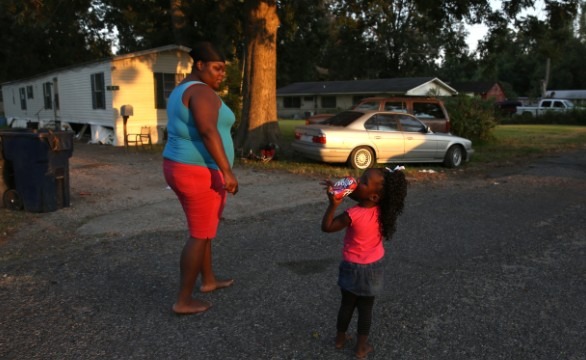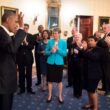(Source: CNN)
Scrooge has come early this year. This holiday season, kids in America’s poorest families are going to have less to eat.
November 1 brought $5 billion in new cuts to the nation’s food stamp program, now officially known as the Supplemental Nutrition Assistance Program, or SNAP.
Poor families will lose on average 7 percent of their food aid, calculates the Center on Budget and Policy Priorities. A mother with two kids will lose $319 over the rest of the current federal fiscal year. The cuts could cost some families a week’s worth of meals a month, says the chief at America’s largest food bank.
| Brazen heartlessness toward America’s most vulnerable goes far deeper than food stamp cuts. |
More cuts are looming. A U.S. House of Representatives majority is demanding an additional $39 billion in “savings” over the next decade. Ohio and a host of other states, in the meantime, are moving to limit food stamp eligibility.
Today’s brazen heartlessness toward America’s most vulnerable goes far deeper than food stamp cuts, as a new Economic Policy Institute report released last week documents in rather chilling detail.
Four states, the report notes, have “lifted restrictions on child labor.” In Wisconsin, state law used to limit 16- and 17-year-olds to no more than five hours of work a day on school days. The new law erases these limits.
Other states are cutting back on protections for low-wage workers of all ages. Earlier this year, the new EPI survey relates, Mississippi adopted a law that bans cities and counties in the state “from adopting any minimum wage, living wage, or paid or unpaid sick leave rights for local workers.”
The sick and elderly aren’t faring all that well either. In Arizona, the governor proposed a health-insurance cutoff that would have tripped some patients up right in the middle of their chemotherapy. Texas is considering Medicaid cuts that could end up closing 850 of the state’s 1,000 nursing homes.
America’s current surge of mean-spiritedness, observes Gordon Lafer, the University of Oregon author of the EPI study, essentially erupted right after the 2010 elections. In 11 states, those elections gave right-wingers “new monopoly control” over the governor’s mansion and both legislative houses.
Lafer links this right-wing electoral triumph directly to growing inequality. A widening income gap, he explains, “has produced a critical mass of extremely wealthy businesspeople, many of whom are politically conservative,” and various recent court cases have given these wealthy a green light to spend virtually unlimited sums on their favored political candidates.
This spending has, in turn, raised campaign costs for all political hopefuls—and left pols even more dependent on deep-pocket campaign contributions.
But America’s new heartlessness reflects much more than this turbocharged political power of America’s rich. An insensitivity toward the problems poor people face, researchers have shown, reflects a deeper psychological shift that extreme inequality makes all but inevitable.
The wider a society’s economic divide, as Demos think tank analyst Sean McElwee noted last week, the less empathy on the part of the rich and the powerful toward the poor and the weak. In a starkly unequal society, people of more than ample means “rarely brush shoulders” with people of little advantage. These rich don’t see the poor. They stereotype them—as lazy and unworthy.
Some cheerleaders for the rich and powerful, adds economist Nancy Folbre, go even further. They attribute unemployment and sluggish growth “to excessively generous public assistance.” Cutting food stamps, for these self-righteous souls, comes to seem an easy solution to all that ails a failing American economy.
Defenders of inequality typically do their musings at a high, fact-free level of abstraction. CNN columnist John Sutter last week brought America down to inequality’s ground level, with a remarkably moving and insightful look at the most unequal county in the United States, East Carroll Parish in Louisiana.
In East Carroll, the rich live north of Lake Providence, the poor south. The two groups seldom interact. East Carroll’s most affluent 5 percent average $611,000 a year, 90 times the $6,800 incomes the poorest fifth of the parish average. Such wide income gaps, Sutter shows, invite “gaps in empathy.”
“Looking across Lake Providence from the north,” as he puts it, “can warp a person’s vision.”
One example of this warped vision: East Carroll’s rich see food stamps as an “entitlement” that rots poor people’s incentive to work. Yet these same affluent annually pocket enormously generous farm subsidies. In 2010, East Carroll’s most highly subsidized farmer grabbed $655,000 from one federal subsidy alone.
The average food stamp payout in the parish: $1,492 per person per year.
What should we do about the rampant inequality in East Carroll Parish—and far beyond? For simple starters, of course, we could end federal farm subsidies for wealthy farmers—and restore food stamps to full strength.
The longer-term task? CNN’s John Sutter has some ideas on that score. He offered last week an eclectic short list that includes everything from raising taxes on the nation’s most privileged to raising minimum wages for the nation’s least.
In 2013 America, sums up Sutter, we’ve come to see stark gaps between rich and poor as “inevitable.” His simple reminder for us all: “They don’t have to be.”
Sam Pizzigati is an Associate Fellow at the Institute for Policy Studies and editor of Too Much: A Commentary on Excess and Inequality. His latest book is The Rich Don’t Always Win: The Forgotten Triumph over Plutocracy that Created the American Middle Class.







0 Comments